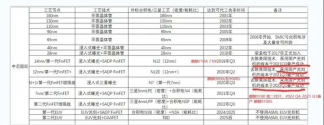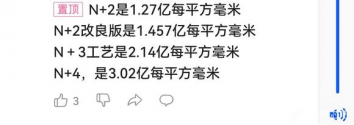yes. he canso bro your opinion will there be a 5nm chip N+3 next year , can he do it?
You are using an out of date browser. It may not display this or other websites correctly.
You should upgrade or use an alternative browser.
You should upgrade or use an alternative browser.
Chinese semiconductor industry
- Thread starter Hendrik_2000
- Start date
- Status
- Not open for further replies.
So we're correct there is a 5nm (DUV) N+3...lol, N+4 is 3nm chip or a 5nm EUVL?
yes. sort ofSo we're correct there is a 5nm N+3...lol, N+4 is 3nm chip or a 5nm EUVL?
So we're correct there is a 5nm (DUV) N+3...lol, N+4 is 3nm chip or a 5nm EUVL?
do you have a table keeping track of this? This is getting complicated with all these advancement.
The whole team should get the award. It is the collective hard work of the company.Liang Mong Song should be awarded National Technology Breakthrough of the Year prize.
Sorry bro we're speculating BUT you never know we might INTO something...lol , from the horses mouth himself, we had this tidbits from his resignation letter which SMIC decline to accept in 2020, there you can see that he mentioned both the 5nm and 3nm. FYI this article is from 2020, so IF we follow the development pattern coupled with at least a viable equipment in NXT 2050i, we might be surprise to see an announcement of a N+3 5nm DUV chip in 2023 with a possible mass production in 2024.do you have a table keeping track of this? This is getting complicated with all these advancement.
At the critical moment of the Sino-US war, SMIC Co-CEO Liang Mengsong resigned due to personnel issues. In his letter of resignation, he disclosed for the first time several new about the development level of ’s chip (also known as chip) industry, including the completion of the development of the 7-nanometer process, and the fact that the 5-nanometer and 3-nanometer processes have not yet started due to some reasons. The progress of domestic chips and the weaknesses still to be resolved.
Former chief operating officer of TSMC, former independent director of SMIC, and former CEO of Wuhan Hongxin Jiang Shangyi decided to return to the nest and serve as vice chairman of SMIC; Liang Mengsong decided to resign and leave the nest because he felt disrespectful because he had not been notified beforehand.
Liang Mengsong revealed in his resignation letter that SMIC’s advanced manufacturing process is fast, and 7-nanometer has been developed and it will enter risk mass production in April next year; as for the more advanced 5-nanometer and 3-nanometer processes, only the extreme ultraviolet (EUV) machine will be in place. , You can enter the full development stage.
Liang Mengsong: I spent three years to complete the original ten years of research and development
He even more bluntly said that he “only used three years to complete the technological deduction that other manufacturers took ten years to achieve.” SMIC should give a full and fair evaluation of his contributions over the past three years.
SMIC is currently the chip company with the highest level of in . The timetable for SMIC’s process improvement disclosed in the resignation letter by Liang Mengsong can be regarded as ’s blueprint for promoting the progress of domestic chips; the highlights include:
One: When will 7-nanometer chips be produced?
What SMIC said in the past is that 7-nanometer chips that do not require EUV lithography machines are expected to be trial-produced at the end of 2020 this year. And Liang Mengsong made it clear here that the 7-nanometer process has been developed and can be put into risky mass production next year. This means that SMIC will step into the advanced process level, and currently have 7-nanometer process , including TSMC, Samsung and Fujitsu.
Second: Timetable for the development of domestic 5nm and 3nm chips
The statement in Liang Mengsong’s letter reflects that the research and development of more advanced processes such as 5 nanometers and 3 nanometers has not yet started. At present, TSMC has mass-produced the highest-end 5-nanometer chip-TSMC’s 5-nanometer process A14 chip, and it has been adopted by Apple. Samsung is catching up with TSMC.
Third: The domestic 5nm and 3nm process encounters key difficulties
Liang Mengsong’s letter revealed that these two updated process chips must wait until the EUV lithography machine can be deployed, which means that they must rely on foreign equipment. Currently, only the Dutch ASML and Japan’s Canon and Nikon are capable of producing EUV lithography machines. Among them, the ASML is recognized as the highest.
However, since the has included SMIC in the export control list, and ASML has never made it clear that it will supply the most high-end EUV lithography machines to , it seems that it is still quite difficult for to obtain EUV lithography machines from the commercial market. It remains to be seen how will break through.
Among the three major messages, SMIC’s lack of the most advanced equipment is the key
On the other hand, Liang Mengsong said in the letter that during this period, he tried his best to complete five generations of development from 28 nanometers to 7 nanometers. This is a task that ordinary companies can take more than ten years to achieve. These results were achieved by more than 2,000 engineers led by him, working hard day and night.
According to industry analysis, Liang Mengsong was already a successful warrior in his previous tenure at TSMC. He was heavily used by TSMC founder Zhang Zhongmou. From him, he “only spent less than one-third of the time of others to achieve the same level of technological development.” From a point of view, the importance of SMIC’s development of its own advanced manufacturing process is self-evident.
The Beijing Daily also analyzed that for SMIC, which is being suppressed by the , whether it is the departure of the mainstay or internal disputes, it will have a negative impact on its current development. After all, in the chip field, SMIC It has not yet entered a market position that can sit back and relax.
The quoted communications expert Liu Qicheng as pointing out that from the perspective of overall chip development and production, SMIC is behind TSMC by about two and a half generations. “SMIC’s biggest problem is being suppressed by external forces, unable to get the latest and greatest equipment, and facing American suppression.”
Editor in charge: Deng Guoqiang
Last edited:
So we're correct there is a 5nm (DUV) N+3...lol, N+4 is 3nm chip or a 5nm EUVL?

From the above table my understanding is that N+1 went into production in Q3 2020, 7nm (aka N+2) in Q4 2021 and the follow up node (5nm?) is in production now (Q3 2022). It looks like the following node (3nm?) will have to wait till EUV is available in 2024/2025 and finally a GAAFET + EUV node ( I suppose this is 2nm) is scheduled for 2025.
Thanks bro, you make me sooo happy, At least we have something to look forward too rather than wait for 3 years for EUVL news.View attachment 96428
From the above table my understanding is that N+1 went into production in Q3 2020, 7nm (aka N+2) in Q4 2021 and the follow up node (5nm?) is in production now (Q3 2022).
So they are doing research by using the SSRF (The Shanghai Synchrotron Radiation Facility), And it tally with the date of the eventual introduction of a Chinese EUVL. So by 2025 the 3nm is production ready with the 2nm the following year in 2026?It looks like the following node (3nm?) will have to wait till EUV is available in 2024/2025 and finally a GAAFET + EUV node ( I suppose this is 2nm) is scheduled for 2025.
WoW!!!, If all of this Plans did come true, SMIC will be on the same level with TSMC, no wonder they are spending such huge amount to stay ahead...lol
Last edited:
- Status
- Not open for further replies.

